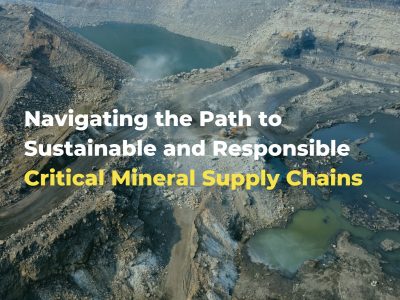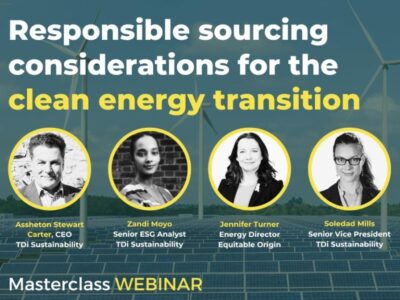
Navigating the Path to Sustainable and Responsible Critical Mineral Supply Chains
TDi’s CEO contributes to new International Energy Agency report on Critical Mineral Supply Chains.
As the world seeks to meet the growing demand for critical minerals essential for clean energy technologies, the extraction and processing of these minerals pose significant challenges. Balancing the surge in demand with responsible practices is crucial to ensuring a sustainable supply of these minerals, according to the International Energy Agency (IEA)’s recent report, “Sustainable and Responsible Critical Mineral Supply Chains”.
Along with experts from the EU, UN, companies involved in minerals and metals; and leading NGOs; TDi’s CEO, Assheton Carter, provided input on the report, which highlights how the environmental, social, and governance (ESG) risks and impacts associated with the production of minerals essential for clean energy, including lithium, nickel, cobalt, graphite, copper, aluminium and rare earth elements, can constrain critical mineral supplies.
The rapid scale-up of clean energy technologies is expected at least to double demand for many minerals and metals by 2030, under the IEA’s Stated Policies Scenario, or increase demand fourfold in the IEA’s Net Zero Emissions by 2050 Scenario, which limits global warming to 1.5°C. The report estimates 164 new mines producing lithium, nickel and cobalt would be needed to achieve the Net Zero Scenario.
The IEA, which has traditionally focused on oil and gas and renewable energy demand and supply scenarios, is now integrating projections for critical minerals demand and supply into its energy scenarios, including in the World Energy Outlook and the Global EV Outlook, reflecting the increasing importance of the mining sector to the clean energy transition.
The report notes that the development of new mines, processing facilities and refineries to meet the increased demand for minerals driven by the clean energy transition brings risks to the environment, communities, and Indigenous Peoples. These factors could constrain critical mineral supplies and therefore, have the potential to delay the much-needed decarbonisation of our global economy. As such, the report emphasises the importance of mitigating these risks to prevent disruptions in the supply of critical minerals crucial for clean energy transitions.
For companies involved in the sourcing or production of critical minerals, the report is a bellwether of emerging trends in ESG risk management and regulation. The report identifies six priority areas crucial for ensuring supply security and the viability of the clean energy transitions:
● Water Stewardship
● Greenhouse Gas Emissions
● Biodiversity Protection
● Human Rights Due Diligence
● Community and Indigenous Peoples’ Engagement, including Free, Prior, and Informed Consent (FPIC)
● Corruption and Governance Risks
One of the report’s key recommendations includes supporting the development of credible voluntary sustainability standards aligned with international frameworks to provide assurance about upstream ESG performance. While voluntary sustainability standards can encourage responsible supply chain practices, their credibility is contingent on factors such as alignment with international frameworks, clarity on scope, transparency, multi-stakeholder engagement, and the quality of assurance mechanisms. Meanwhile, some companies are entering into long-term offtake agreements directly with mining companies or even direct investments in mining activities to gain greater assurance about the upstream source of materials.
The report emphasises the need for more transparent reporting, citing that six of the top ten cobalt companies, together accounting for almost 40% of global cobalt production, did not publish sustainability reports or data for 2022. The report notes that companies should enhance transparency throughout the supply chain by undertaking due diligence and publicly reporting on risks and mitigation actions.
Another key theme among the report’s policy recommendations is traceability. Ensuring traceability and chain of custody is crucial. For instance, to receive tax credits under the Inflation Reduction Act (which limits tax credits to vehicle batteries using critical minerals sourced, processed or recycled from specific regions) companies need to demonstrate the origin of the minerals through traceability, chain of custody systems or identification of upstream actors.
The report also notes that the critical minerals industry can only be truly “sustainable” if the supply chain is fully circular, with all or close to all material re-entering the supply chain at its end of life. Furthermore, ensuring that clean energy transitions are equitable and people-centred can help to avoid supply disruptions that can slow clean energy deployment.
Achieving sustainable and responsible critical mineral supply chains requires a collaborative effort from companies, governments, and international organisations. By adhering to transparent reporting, embracing sustainability standards, and ensuring that companies have the right incentives to prioritise ESG considerations, industry can navigate challenges and contribute to a cleaner and more sustainable energy future.
 Automotive
Automotive
The Dark Side of Electric Vehicle Supply Chains – Understanding Free, Prior and Informed Consent
18th July 2024 Critical Minerals
Critical Minerals
What You Need to Know about Double Materiality and the Corporate Sustainability Reporting Directive (CSRD)
28th May 2024 Critical Minerals
Critical Minerals
